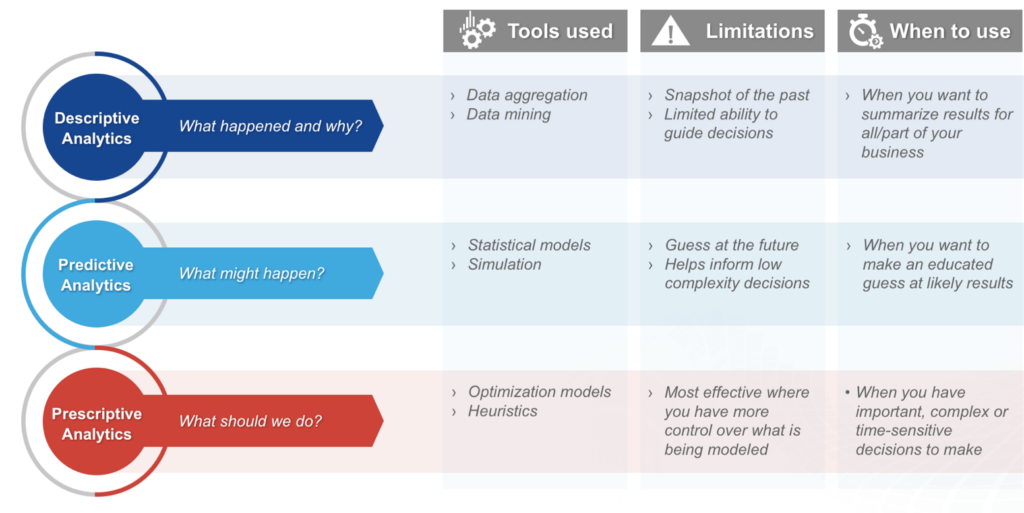




Prescriptive analytics tools like Gurobi equip you to make optimal business decisions in the midst of extreme complexity. For example, you can decide exactly which products to produce, in which quantities, in which order, and in which facilities, while taking into consideration production minimums, manufacturing time and costs, raw material inventory, and inventory capacity, in order to minimize total product costs.
Prescriptive analytics is one of the three main types of data analytics, as show below:

Predictive analytics tools—like machine learning, statistical models, and simulations—seek to find patterns in data, in order to predict what might happen in the future. For example, you can estimate industry growth, raw material pricing, revenue or profit growth, or changes in demand by product line.
Predictive analytics looks for patterns in historical data and uses those patterns to make predictions about the future. Prescriptive analytics can help you find the optimal way to achieve your business goals, given those predictions.
For example, if you were planning a trip, machine learning can predict what you may encounter along your journey (weather, traffic, engine trouble). But with mathematical optimization, you can take those predictions into consideration, as well as your goals (fastest, cheapest, safest route) and constraints (time, budget, speed limits), and identify the single best road you should take.
One popular prescriptive analytics use case is marketing campaign optimization—enabling you to offer the right product to the right person at the right time, so you can maximize your marketing ROI while satisfying your business constraints.
Another example is production planning:
Your goals/objectives:
Your constraints:
Your decision variables (the questions you need answered):
Other examples include inventory optimization, location planning, portfolio management, vehicle routing, workforce scheduling, and more.
We make it easy for students, faculty, and researchers to work with mathematical optimization.
When you face complex optimization challenges, you can trust our Gurobi Alliance partners for expert services.
Our global team of helpful, PhD-level experts are here to support you—with responses in hours, not days.
GUROBI NEWSLETTER
Latest news and releases
Privacy Policy | © Gurobi Optimization, LLC. All Rights Reserved.
| Cookie | Duration | Description |
|---|---|---|
| cookielawinfo-checkbox-advertisement | 1 year | Set by the GDPR Cookie Consent plugin, this cookie is used to record the user consent for the cookies in the "Advertisement" category . |
| cookielawinfo-checkbox-analytics | 11 months | This cookie is set by GDPR Cookie Consent plugin. The cookie is used to store the user consent for the cookies in the category "Analytics". |
| cookielawinfo-checkbox-functional | 11 months | The cookie is set by GDPR cookie consent to record the user consent for the cookies in the category "Functional". |
| cookielawinfo-checkbox-necessary | 11 months | This cookie is set by GDPR Cookie Consent plugin. The cookies is used to store the user consent for the cookies in the category "Necessary". |
| cookielawinfo-checkbox-others | 11 months | This cookie is set by GDPR Cookie Consent plugin. The cookie is used to store the user consent for the cookies in the category "Other. |
| cookielawinfo-checkbox-performance | 11 months | This cookie is set by GDPR Cookie Consent plugin. The cookie is used to store the user consent for the cookies in the category "Performance". |
| CookieLawInfoConsent | 1 year | Records the default button state of the corresponding category & the status of CCPA. It works only in coordination with the primary cookie. |
| elementor | never | This cookie is used by the website's WordPress theme. It allows the website owner to implement or change the website's content in real-time. |
| viewed_cookie_policy | 11 months | The cookie is set by the GDPR Cookie Consent plugin and is used to store whether or not user has consented to the use of cookies. It does not store any personal data. |
| Cookie | Duration | Description |
|---|---|---|
| __cf_bm | 30 minutes | This cookie, set by Cloudflare, is used to support Cloudflare Bot Management. |
| Cookie | Duration | Description |
|---|---|---|
| CONSENT | 2 years | YouTube sets this cookie via embedded youtube-videos and registers anonymous statistical data. |
| Cookie | Duration | Description |
|---|---|---|
| VISITOR_INFO1_LIVE | 5 months 27 days | A cookie set by YouTube to measure bandwidth that determines whether the user gets the new or old player interface. |
| YSC | session | YSC cookie is set by Youtube and is used to track the views of embedded videos on Youtube pages. |